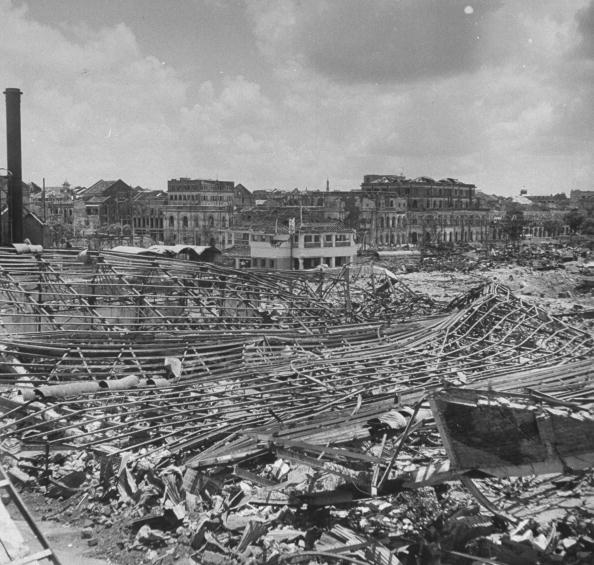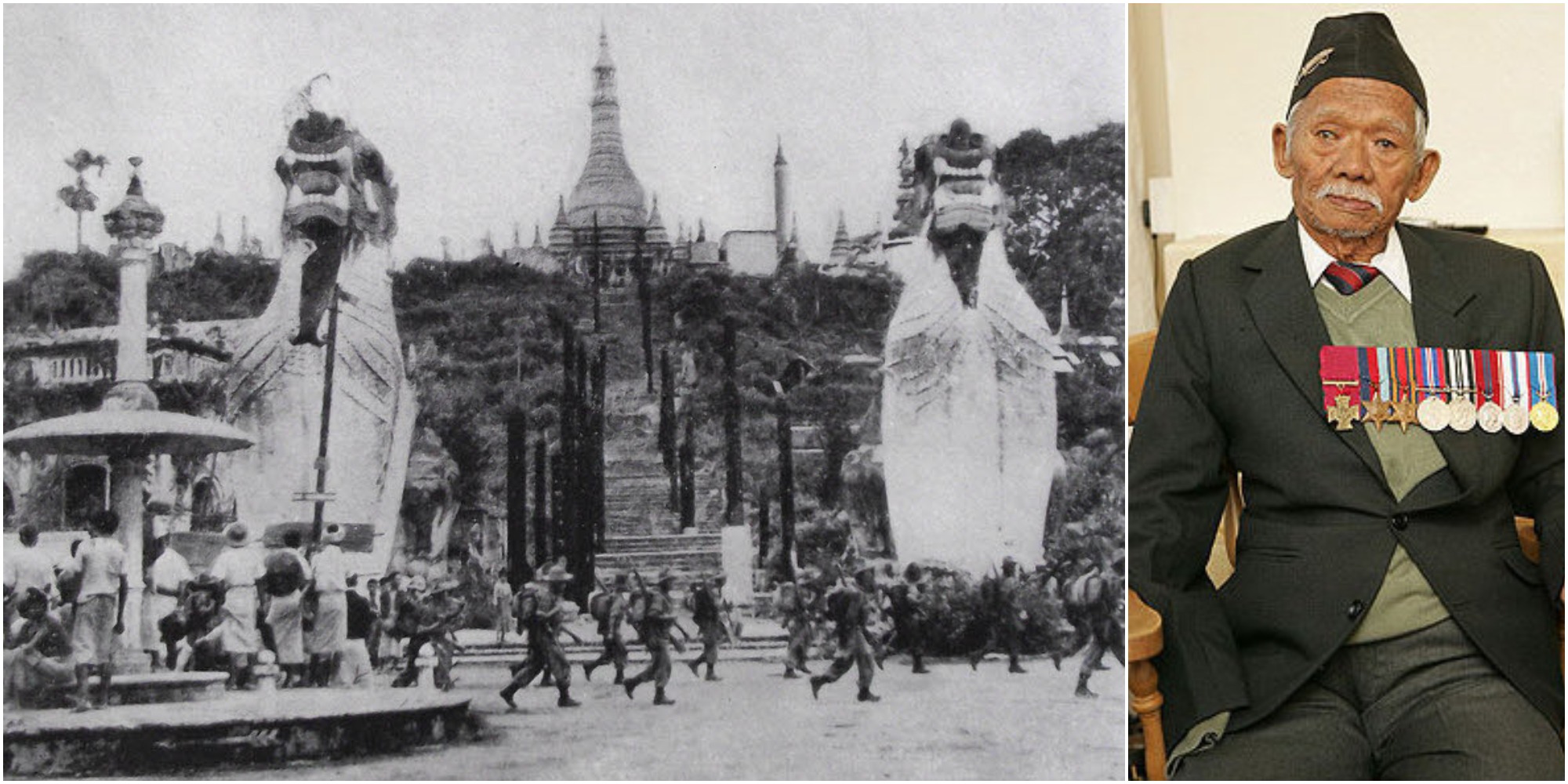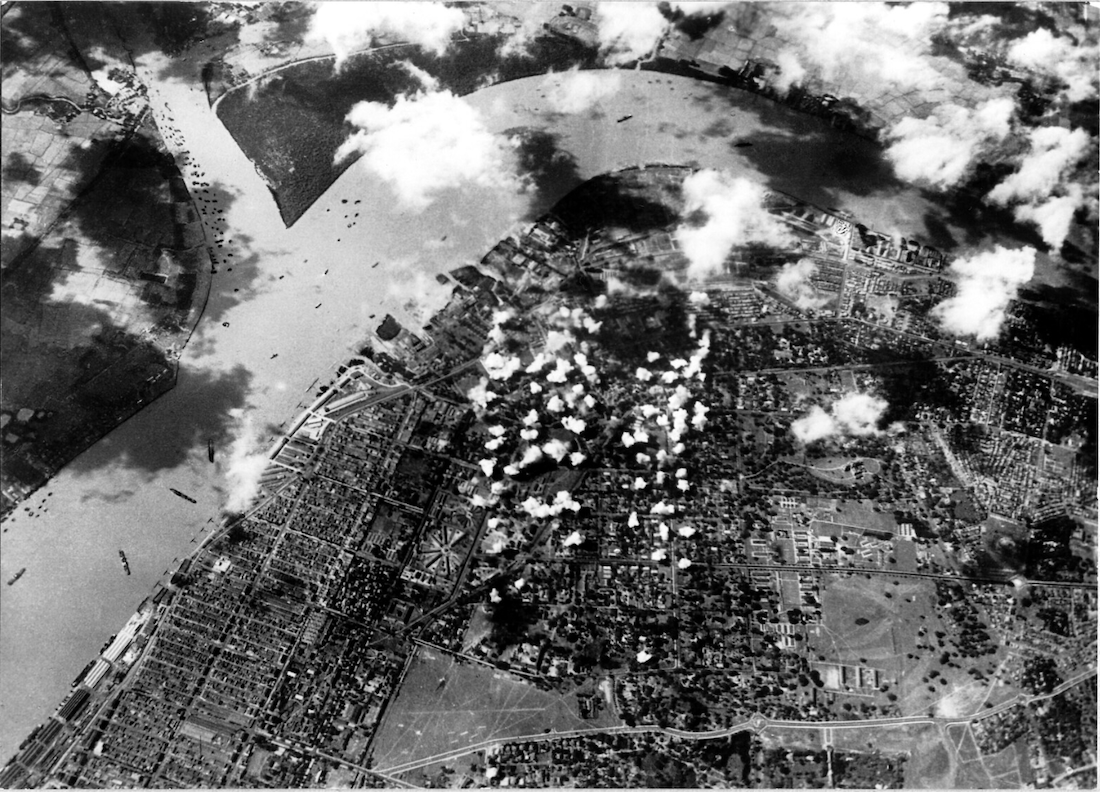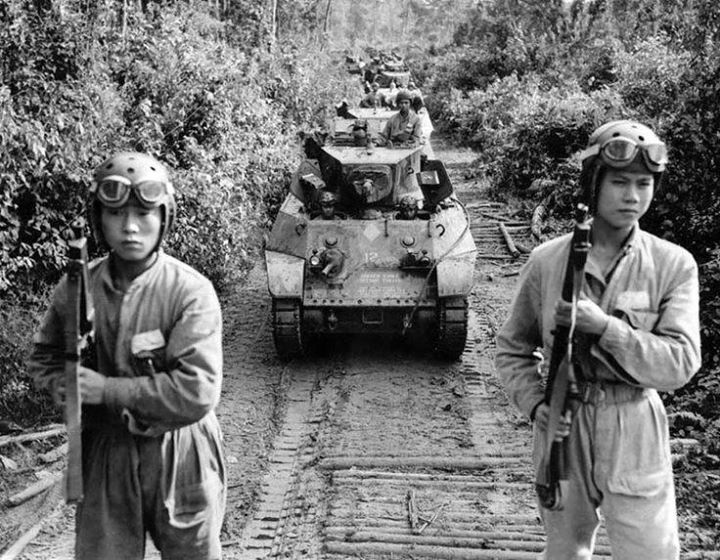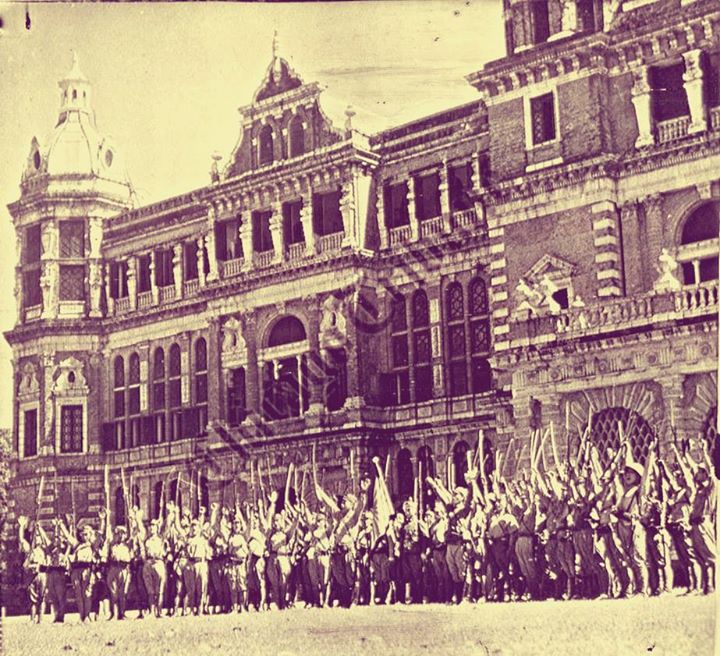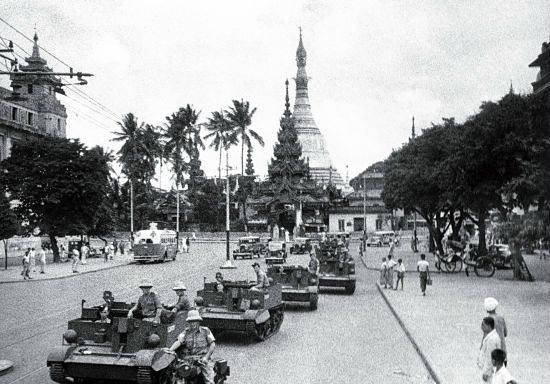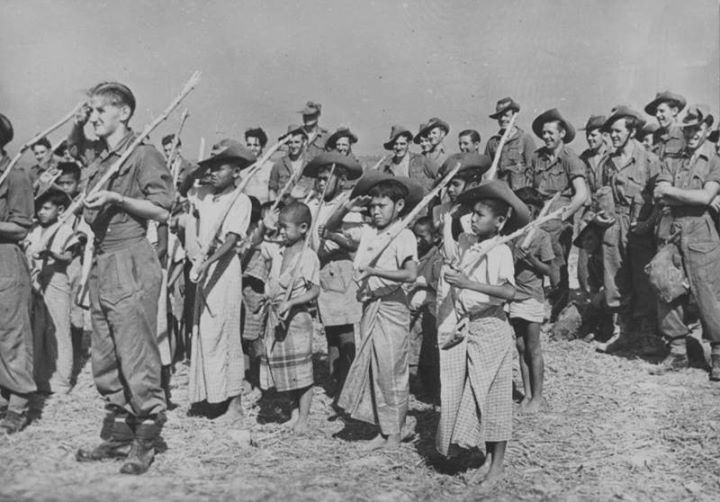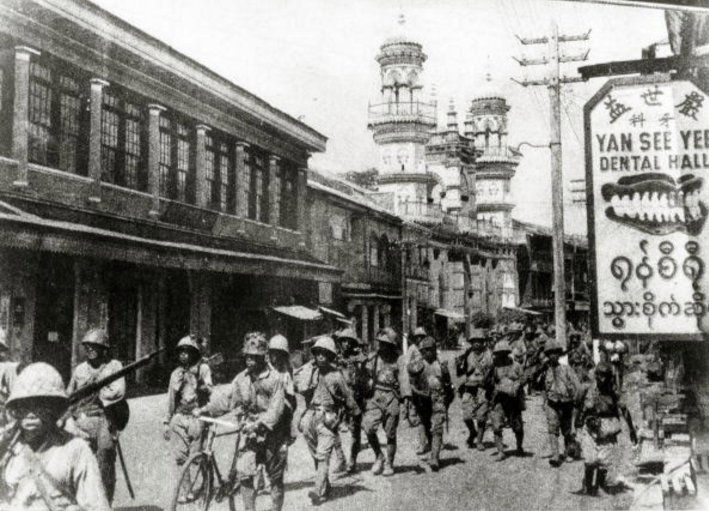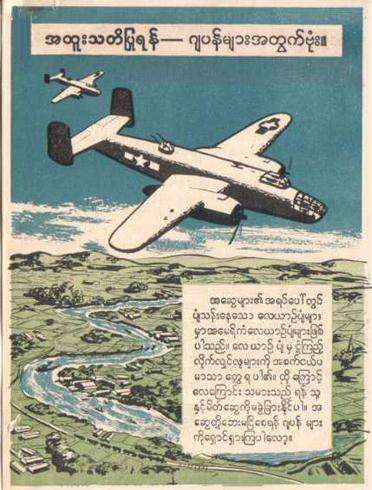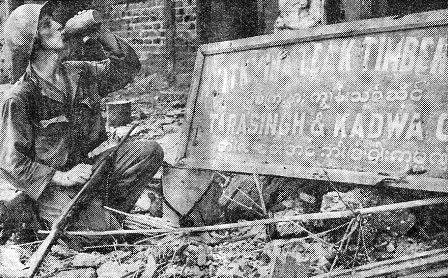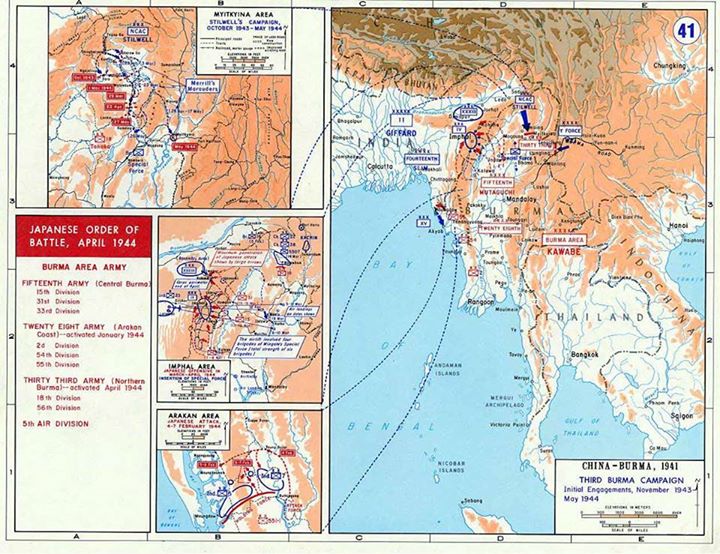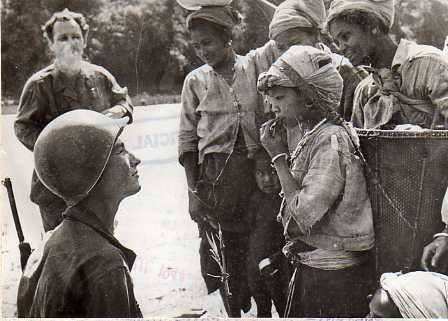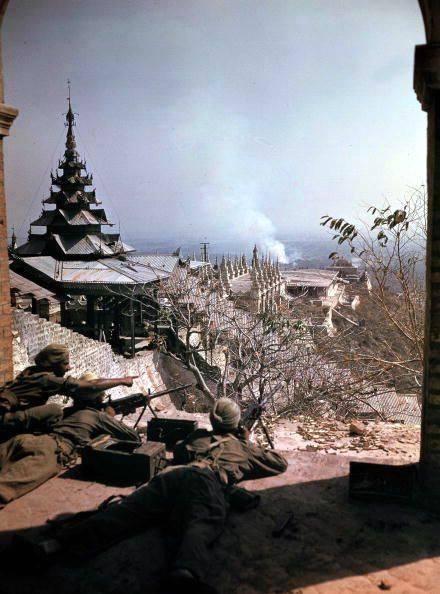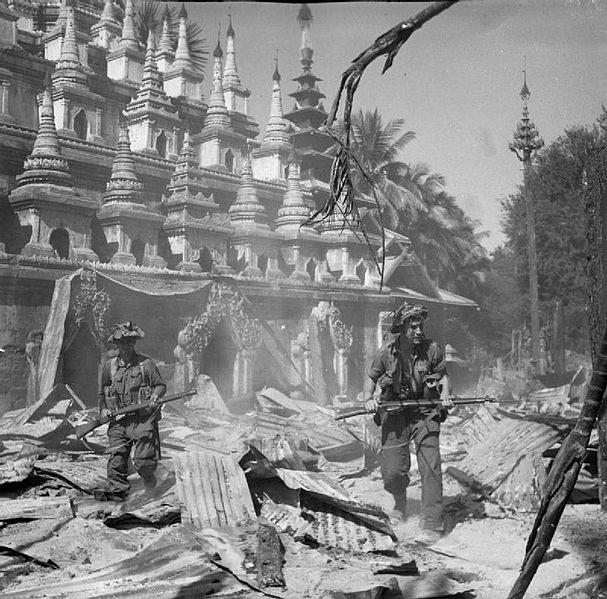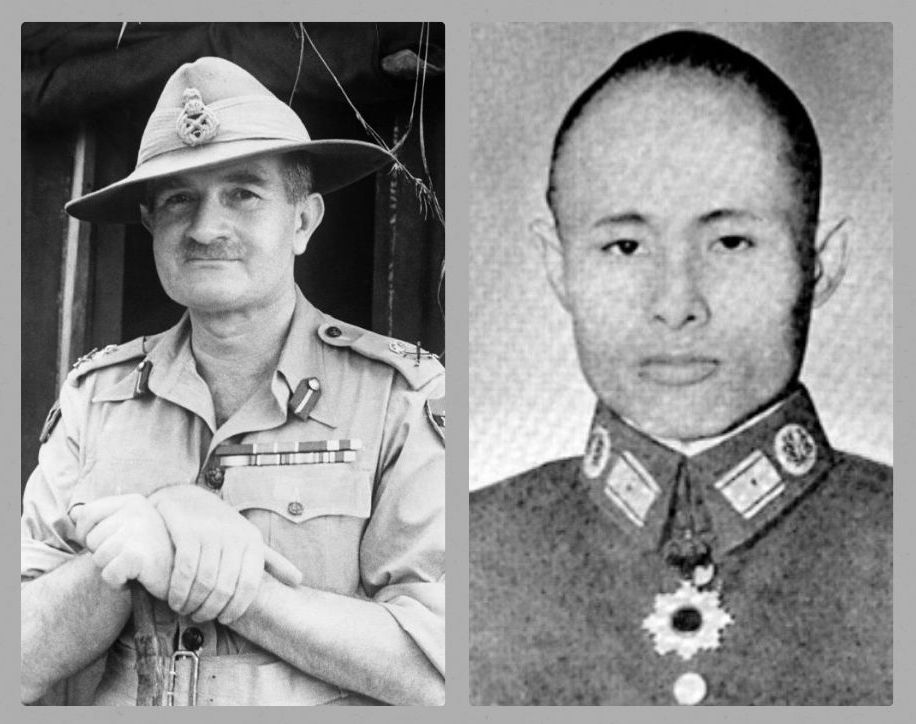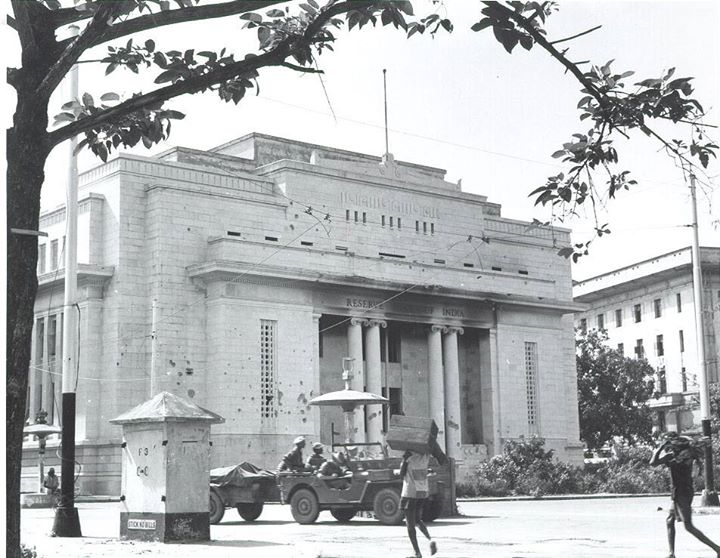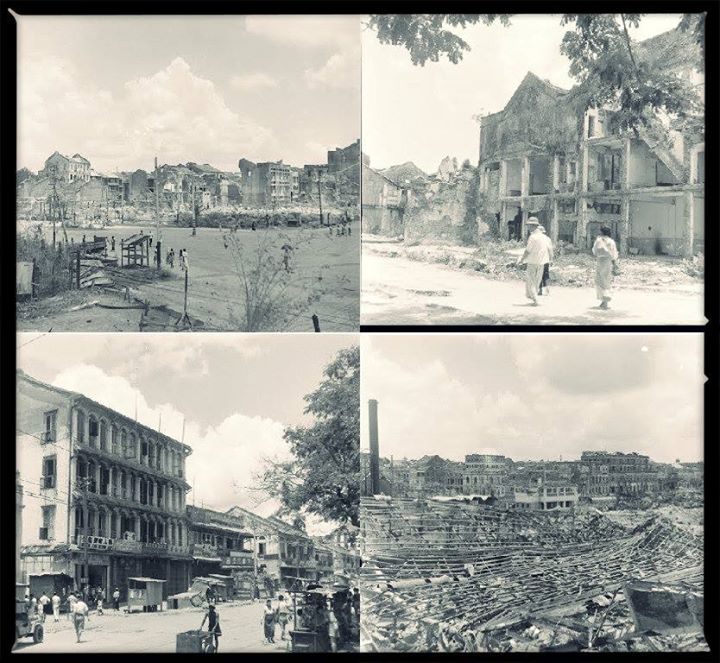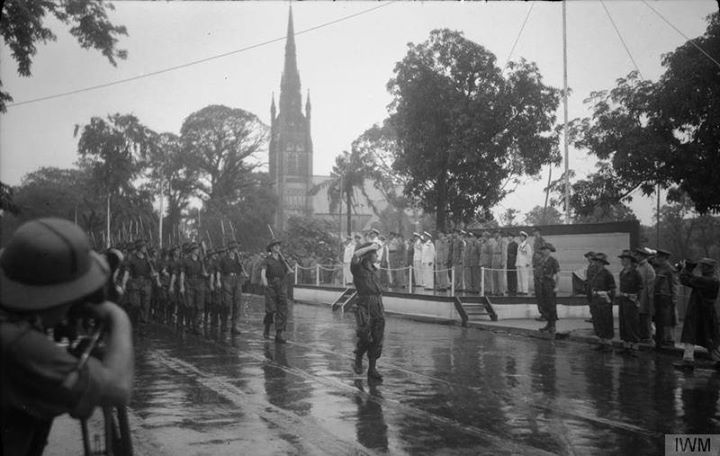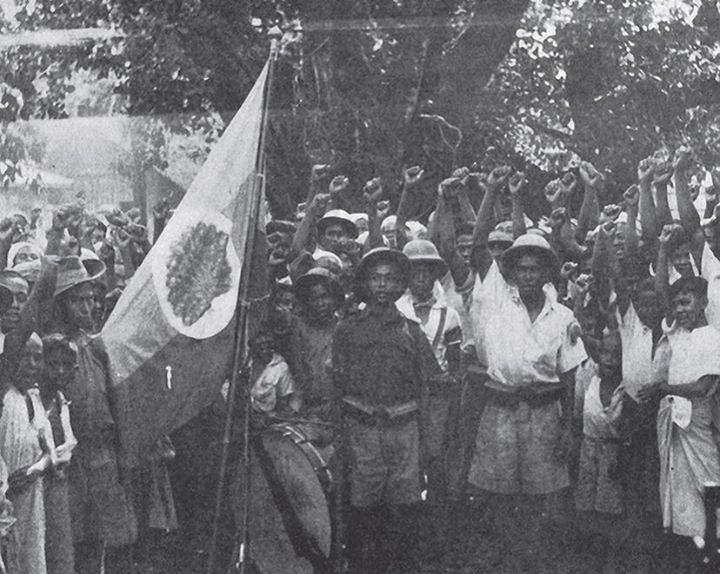World War Two (1942-1945)
Burma was the site of some of the most important land battles of World War Two. It was also the setting for some of the most humiliating defeats the British would face during the war – it would take the combined powers of the Allied forces and the might of multiple armies to win Burma back from the Japanese.
While the Allied forces were ultimately victorious in Burma, the country was left in ruins. The political progress of the preceding years – the attempts at constitutional reform and the path to self-governance that had been established – was in tatters and would be replaced by a militant nationalism that has dominated the country to the present day.
The essays, stories, photographs, and battle plans included in this section explore the intersections between the global war, the military history of Burma during that time, and the local politics that emerged from the wreckage.
Aftermath of World War Two in Myanmar
Half a million American, British, Indian, Chinese, Japanese and other soldiers fought in Burma, during World War Two, leading to the devastation of almost every single city and town, every port, airport, train station, oil field and factory. Over 200,000 soldiers died, together with an unknown number of civilians. The war left behind an economy in ruins and a country awash in guns, leading directly to the civil wars that followed. In thinking of World War Two in Burma, the...
Read MoreGurkhas in Myanmar
Over 300,000 people in Myanmar are of Nepali ancestry. Many if not most are the descendants of Gurkha soldiers stationed in Burma during British rule. Nepal's modern history begins in the mid-18th century with the unification of the Kathmandu valley by Prithvi Narayan Shah of the Gorkha kingdom. Following the Anglo-Nepali War of 1815-16, the British East India Company began recruiting soldiers from Nepal. They called the soldiers "Gurkhas". They were generally recruited from upland communities such as the Tamang...
Read MoreWorld War Two came to Rangoon before Christmas
On 23 and 25 December 1941, the Japanese Empire attacked Rangoon for the first time. Over 80 Japanese Mitsubishi Ki-21 bombers escorted by 30 Nakajima fighter planes flew from bases in Thailand and Indochina. Tomahawk and Buffaloes planes of the UK's Royal Airforce and the US Army's "Flying Tigers" attempted to intercept the Japanese invasion force with only limited success. The Japanese used high explosive and incendiary bombs over Rangoon's entire downtown from Pazundaung to Ahlone, destroying around three-fifths of...
Read MoreFlying Tigers: Defenders of Rangoon
In December 1941, the "Flying Tigers" arrived at Mingaladon to defend Rangoon from the Japanese. Though outnumbered, the Flying Tigers managed to down 50 enemy planes over Rangoon (losing 10 of their own). The 1st American Volunteer Group, also known as the "Flying Tigers", were United States airmen authorized by President Roosevelt to support China and protect the Burma Road. As the US was not yet at war with Tokyo, this was a clandestine operation. The Flying Tigers were under...
Read MoreRetaking Myitkyina
The Allied 14th Indian Division began its (unsuccessful) attempt to seize the Mayu peninsula back from the Japanese in December 1942. At the same time, the British and Gurkha special forces (the "Chindits") were preparing for their first attempt to push deep behind Japanese lines in northern Burma ("Operation Longcloth"). The Japanese were then also battling the Chinese in Yunnan, whose 5th and 6th armies had tried in vain that year to hold the Shan states and, in 1943, would...
Read MoreFall of Rangoon
On 8 March 1942, Rangoon fell to the Japanese after two and a half months of heavy aerial bombing. At least 2,000 civilians were killed by the bombing, and another 400,000 became refugees. In a “scorched earth” policy, the city’s dockyards, factories, oil refinery, and railways were all destroyed by the colonial authorities before they evacuated. Hundreds of offices and shops were looted by ordinary people. The fighting retreat from Rangoon (first to Mandalay and then to Assam) over the...
Read MoreThe last attempt to defend Rangoon
In February 1942 Rangoon was in near chaos, with hundreds of thousands of refugees fleeing the heavily bombed downtown area and dockyards. Electricity lines were severely damaged and food supplies were running short. By 15 February, Singapore had fallen to the Japanese. On 17 February, the Australian government under Prime Minister John Curtin refused Sir Winston Churchill’s directive to divert the 6th and 7th (Australian) Divisions to the defence of Rangoon. Meanwhile, the Japanese 15th Army continued to advance north...
Read MoreThe Capture of Mandalay
On the night of 3 April 1942, Japanese Mitsubishi bombers attacked the old royal city with incendiary bombs, creating a gigantic firestorm. Two-thirds of all the buildings in Mandalay were destroyed. It is estimated that up to 8,000 people may have died and many more were injured (out of a population of about 150,000). Blackened and rotting corpses filled the moat around Mandalay Palace. Everywhere in the searing hot-season heat was the smell of death. The city emptied. Clare Booth...
Read MoreWhen Australia changed Burmese history
On 23 December 1941, the Japanese army began the aerial bombing of Rangoon, then crossed the border from Thailand by land, seizing Moulmein at the end of January. On 15 February, Singapore - Britain's "impregnable" fortress in the Far East - fell, and 80,000 Allied troops were captured. On 19 February, the Australian town of Darwin was bombed by the Japanese. By late February, the Japanese 15th Army was fast approaching Rangoon, defeating the 17th Indian Division, and crossing the Sittang...
Read MoreFall of Moulmein
On 26 January 1942, the 55th Division of the Japanese 15th Army under Lt. General Shojiro Iida attacked Moulmein. Japan's principal aim was to cut the Allied supply line from Rangoon to Chiang Kai-shek's China, "The Burma Road". The 55th Division, under Lt. General Hiroshi Takeuchi, which advanced on the city from the east via Kawkareik and Kyondo having crossed the border from Thailand. The 33rd Division approached from the northeast from Pa-an. Tavoy had already fallen on 19...
Read MoreBattle of Lashio
On 29 April 1942, the 56th Division of the Japanese imperial army defeated forces of the Kuomintang's "Chinese Expeditionary Force (Burma)" and seized Lashio. During a devastating five-hour battle, Lashio was burned to the ground. The Japanese victory effectively cut the "Burma Road", the motorway linking Lashio to Kunming which had been built in 1939 as China's main lifeline to the Allies. The Japanese invasion of Burma had begun four months before. Washington and London had asked for help from...
Read MoreDr. Ba Maw in Tokyo in 1943
In March 1943, Dr Ba Maw travelled to Tokyo (together with Thakin May, U Thein Maung, and General Aung San) for discussions with Japanese Prime Minister Hideki Tojo and others. Five months later, Dr Ba Maw would be proclaimed the adhipati (Leader) of the State of Burma and an ally of the Axis Powers. The Burmese delegation's arrival at Haneda airport in Tokyo was featured on this cover of the Japanese magazine, Shashin Shuho. In the background of both photographs...
Read MoreStay away from the Japanese!
An American air force leaflets from 1943 explaining to Burmese villagers that the Allied bombs falling on their country are not meant for them but for the Japanese. The text reads, “The airplanes flying in your region are American planes. Looking down from the planes, people on the ground only look like little dots so soldiers in the planes can not tell friend from foe. In order to stay safe [and avoid being targeted], keep your distance from Japanese troops."
Read MoreCairo Conference
This photograph shows Allied leaders US President Franklin Roosevelt, British Prime Minister Winston Churchill, and China's Generalissimo Chiang Kai-shek discussing the reconquest of Burma at their summit in Cairo. Also at the conference were Madame Chiang Kai-shek (far right in this photo), the new Allied Supreme Commander for South East Asia, Lord Louis Mountbatten, and his deputy General Joseph "Vinegar Joe" Stillwell. The Chinese pressed for an aggressive invasion of Burma (by British, Indian, and American as well as Chinese...
Read MoreAn Old Flag of Myanmar
The current tricolour was first adopted in the 1930s by Dobama Asiayone (the ultra-nationalist "We Burmans" association). Its design was intitally inspired by the 1919 flag of the Irish Republic. While the Dobama placed a peacock at the flag's centre, leftist elements also introduced a hammer-and-sickle version. The flag of British Burma also had a peacock, but one that was off-set and overshadowed by the Union Jack in the top left corner. During World War Two, when the occupying Japanese...
Read MoreHistoric Siege of Myitkyina
Beginning 17 May 1944, Chinese and American forces (including "Merrill's Marauders" ) supported by Kachin and other Allied troops laid siege to Japanese-held Myitkyina. It was a critical battle of World War Two, leading to the capture of the all-important Myitkyina airstrip. Myitkyina was captured after only 78 days of savage fighting against an entrenched Japanese garrison. Altogether nearly 10,000 men were killed or wounded during the historic siege. The Japanese had put up a fierce defence against almost impossible...
Read MoreBattles of Imphal and Kohima
The epic battles of Imphal and Kohima started on 4 April 1944 and ended with an Allied victory on 22 June 1944. They are considered by many to be the Asian equivalent of Stalingrad - pivotal battles that turned the tide of World War Two. These battles were Japan's greatest embarrassment during the war; if Japan had won and been able to push onwards from Imphal into Bengal, the histories of India and Burma - perhaps the whole world -...
Read MoreAmerican Soldier in Kachin in 1944
Taken in March 1944, this photograph shows American Private Wayne Martin offering gum to a child. PFC Martin was one of "Merril's Marauders", the American special operations unit that fought behind Japanese lines and this photograph was taken during the unit's successful campaign to take Walawbun in the Hukawng Valley. The operation, involving some 2,750 men and conducted in cooperation with a Chinese armoured battalion, took five days and resulted in 800 enemy killed, with eigh Marauders killed and 37...
Read MoreBurma in 1944
In March-April 1944, three Japanese divisions and one division of the Indian National Army under Subhas Chandra Bose were decisively beaten at Imphal and Kohima by British and Indian forces. Some 60,000 Japanese were killed. In May 1944, three Chinese armies together with American special operations unit "Merrill's Marauders" attacked Myitkyina. The town and airstrip were taken only after a three-month siege and a ferocious resistance by the Japanese 33rd Army. Over the same months, the Allies landed more than...
Read MoreSurrender of Japan
On 2 September 1945, the Empire of Japan formally surrendered to the Allied powers on board the USS Missouri. Over 100 Allied warships and submarines were present that day in Tokyo Bay. The Allied powers were represented by General Douglas MacArthur, Supreme Allied Commander. This photograph, from the Army Signal Corps Collection in the US National Archives shows the Japanese side, represented by Foreign Minister Shigemitsu Mamoru (front row, top hat) as civilian plenipotentiary and General Yoshijiro Umezu (standing next...
Read MoreThe Japanese surrender at Government House, Rangoon
On 12 September 1945, General Ichida Jiro, Acting Chief of Staff of Japan's Burma Area Army, formally surrendered to Brigadier E.F.E. Armstrong (Chief of Staff to Lieutenant-General Sir Montague Stopford, General Officer Commanding of the British Twelfth Army) at Government House, Rangoon. On the same day, Lord Louis Mountbatten, Supreme Allied Commander South East Asia received the Japanese surrender in Singapore. Five days earlier on 7 September, Lord Mountbatten and General Aung San had signed an agreement at Kandy in...
Read MoreThe 1945 Conquest of Burma
The Axis powers were then everywhere in retreat. British and American forces were crossing the Rhine, and Soviet armies - over two million strong - had taken Poland and were approaching Berlin from the east. In the Pacific, American Marines had defeated the Japanese at Iwo Jima and begun the firebombing of Tokyo. Fifteen months earlier, at the Cairo Conference in Egypt, the leaders of the new United Nations, Franklin D. Roosevelt, Winston Churchill, and Chiang Kai-shek, agreed on an...
Read MoreLedo or Stillwell Road
The "Ledo" or "Stillwell" Road was completed on 28 January 1945. The road linked Ledo in Assam with Kunming in Yunnan via the Kachin Hills. It was the first and is still the only modern road to connect India and China across Myanmar. The idea for the road began in 1942 after Japanese forces seized Rangoon and cut the old "Burma Road". The Burma Road began in Rangoon and went via Mandalay and Lashio to Yunnan. It was the critical...
Read MorePyinmana during World War Two
On 20 April 1945, Allied forces led by the 5th Indian Division were seizing control of Pyinmana (now Naypyitaw). It was the headquarters of the Japanese 33rd Army and its commander, General Masaki Honda, only just managed to escape in the dark on foot. Hundreds of other Japanese were killed. The 5th Indian Division - with Scots, Pathan, Sikh, English, Gurkha, Punjabi and other troops - had fought the Italians in East Africa and the Germans in North Africa, as...
Read MoreRelationship Between Lt. General Slim and General Aung San
General Aung San crossed the Irrawaddy at Allanmyo on 15 May 1945 and then flew to Meiktila on 16 May to meet for the first time with Lt. General William Slim, commander of the British Fourteenth Army. With nearly one million men, the Fourteenth Army was the largest Commonwealth army anywhere during World War Two - a giant force of Indians, Africans, British, Gurkhas, Burmese, Canadians, Australians and others. By 16 May, the Fourteenth Army had already retaken Rangoon and...
Read MoreBritish Patrol in Rangoon
This picture, taken in May, 1945, shows troops of the British Fourteenth Army (likely 17th Indian Division) patrolling Rangoon just days after the Japanese retreat. The war-damaged Reserve Bank of India (later Central Bank) is in the background. A closer look at the jeep shows three Indian soldiers as well as a British soldier reading a map; he may have worked out that he is on Merchant Street heading west past Sule Pagoda Road.
Read MoreWar-damaged Rangoon
In the first week of May 1945, Allied troops led by the Indian 17th and Indian 26th Divisions retook Rangoon from the Japanese who retreated to Moulmein. It was the same week Adolf Hitler committed suicide and Germany surrendered. Many people do not realize how badly damaged Rangoon was from the war, from Allied as well as Japanese bombing, and three-and-a-half years of occupation. The dockyards, railways, factories, oil refineries, and much basic infrastructure had been completely destroyed. The city...
Read MoreAllied Forces Holding a Victory Parade Along Shwedagon Pagoda Road
On 15 June 1945, Allied forces under Supreme Allied Commander South East Asia Admiral Lord Louis Mountbatten held a victory parade over the Japanese Empire. Lord Louis Mountbatten took the salute together with other Allied commanders including General Aung San, who had just been given the rank of "Deputy Inspector General". The march past included units of the Indian Army, the Royal Navy, the Royal Marines, the US Army, the Chinese Army, and the "Patriotic Burma Forces" under General Aung...
Read MoreBattle on Mandalay Hill
This photograph showing men of the 11th Sikh Regiment was taken during the fight for Mandalay Hill between the 19th Indian Division and defending Japanese imperial forces. Mandalay Hill was eventually seized by a mix of British, Gurkha, Sikh and Punjabi units in March 1945. The 44th Gurkhas had successfully stormed the Hill the night of 8 March, reaching the summit the next morning. But the Japanese had hidden themselves in dozens of concrete tunnels and bunkers. For two days,...
Read MoreArmed Forces Day
Armed Forces Day marks the anniversary of the fateful decision by the Burma National Army in March 1945 to revolt against the Japanese and side with the Allies. After a parade on 27 March in Rangoon, the BNA marched out of the city and began attacking Japanese positions in the delta and in the Pyinmana-Toungoo area (exactly where Napyitaw is now). The war in Burma was then nearly over. Nearly a million British, African, Indian, Gurkha, Chinese, and American troops...
Read More